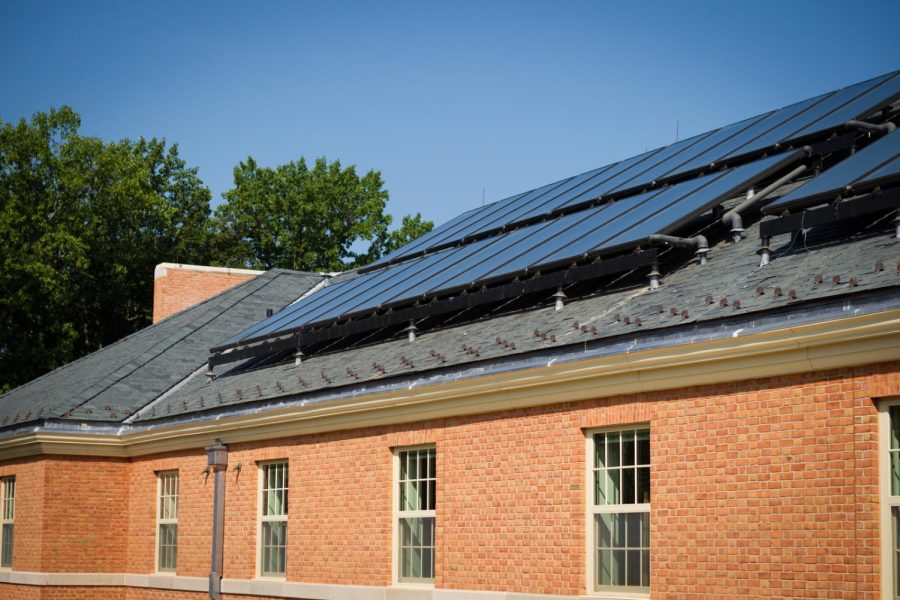Solar energy from a foreign land
How our university is working past Duke Energy’s solar restrictions for a greener future
Solar panels adorn the roof of South Residence Hall.
October 5, 2022
Despite the many green initiatives Wake Forest University has spearheaded, there remains a lack of significant renewable energy presence in ‘the forest.’
In reality, similar to many other universities, Wake Forest is dedicated to reducing its greenhouse gas emissions and has a goal to be carbon neutral by 2040, according to the Office of Sustainability. Sustainability efforts on campus have taken a multitude of forms, but the lack of solar energy on campus is perhaps one of the most notable absences in the realm of emissions.
In order to understand why solar energy on campus is limited, efforts that the university has taken to reduce emissions must be examined first.
According to data collected by the university since 2007, university-wide carbon expenditure dropped 47% in the last twelve years, largely due to energy efficiency efforts spearheaded by Campus Facilities. Initiatives like increased insulation in buildings, LED lighting, automatic sensors, and other building improvements have been the main factors behind carbon reduction.
While Lindsay Batchelor, Director of the Wake Forest Office of Sustainability, is ecstatic about the progress that’s been made, she says that the remaining 53% of carbon emissions will likely be the hardest to reduce.
“Once you cut off anything that would be considered a low-hanging fruit then you get to the harder stuff,” Batchelor said.
One of the most obvious ways of reducing carbon emissions outside of energy efficiency efforts is the utilization of renewable energy. Given Wake Forest’s location and climate, as well as financial considerations, the best renewable energy option available both on and off campus is solar energy.
However, multiple factors make it incredibly difficult for the university to install significant amounts of solar energy on campus.
The number one culprit? Duke Energy.
As the largest provider of electricity in North Carolina, Duke controls all of the energy-related infrastructure Wake Forest is allowed to build and limits renewable energy efforts in a couple of different ways.
Dr. Stan Meiburg is the Executive Director for Energy, Environment and Sustainability at Wake Forest. Prior to working at Wake Forest, Meiburg worked for the Environmental Protection Agency (EPA) for 39 years and served as the Acting Deputy Administrator from 2014-2017.
Meiburg explained that Duke Energy limits renewable energy efforts through control of nearly the entire energy market in the state of North Carolina.
“Generally, what happens in non-monopoly states is that you have independent renewable energy producers who will build a renewable energy plant and sell the electricity back to the grid,” says Meiburg. “[In contrast], in a regulated monopoly state [like North Carolina], Duke controls the access to the market itself.”
As Batchelor explains, Duke’s monopoly also allows them to prevent consumers like Wake Forest from entering the market.
“Duke Energy gets to decide through a regulation called net metering the amount of solar [energy] that we can have on our campus that is connected to the grid,” Batchelor says. “Duke Energy gets to decide that we have a maximum of one megawatt of renewable energy at any given time that is connected to the grid.”
On a campus that, in its energy-reduced and efficiency-minded state, uses around 11 megawatts of energy per year, this presents significant obstacles when it comes to offsetting carbon emissions.
Batchelor is quick to point out that the installation of solar panels on every single building on campus is not feasible, nor would it produce the electricity needed to power the entirety of campus. However, net metering significantly limits possibilities when it comes to how much Wake Forest’s on-campus carbon emissions can be cut.
Currently, there are five solar panels on Wake Forest property. At the Barn, the Reynolda Gardens greenhouse and North Dining Hall, solar panels provide a small amount of electricity required by each of these buildings, and solar units on top of South Hall and the Reynolds Gym provide the energy needed to heat water in each of the respective buildings. These five solar panels account for a small fraction of energy use on campus, but there are continuous conversations about increasing solar presence on campus to the maximum of one megawatt that is allowed by net metering laws in North Carolina.
“Right before the pandemic [began],” said Batchelor, “we were about to ink a contract with a third-party leasing partner that was going to put a megawatt of solar on our campus, and the pandemic got in the way of that.”
Batchelor explained the labor shortages and supply chain disruptions caused by COVID-19 led to a massive disruption in the renewable energy industry. Because of this, the prices of renewables skyrocketed alongside the prices of building materials and labor that would be needed to make repairs to roofs on campus before solar panels could be installed.
Moving forward, the Office of Sustainability is hopeful that the university will install the one megawatt maximum of renewable energy on campus. Additionally, the Biden Administration’s passage of the Inflation Reduction Act promises to provide investment into renewable energy and many hope that this will tame the renewable energy market.
“The Inflation Reduction Act is going to be very helpful [not only] for consumers,” said Meiburg, “…[but also] for nonprofit institutions [like Wake Forest] who don’t pay taxes [because it allows them] get a credit against expenses that they incur adopting renewable energy.”
One of the most common ways universities and businesses, including Wake Forest, are looking into reaching their carbon neutrality goals is through investment in renewables through a Virtual Power Purchase Agreement (VPPA).
As Batchelor explains it, the goal of investment into a VPPA is not, like many other investments, to make money. Instead, investment into a VPPA is solely for the purpose of gaining what Batchelor calls “renewable energy credits.” Through a VPPA, Wake Forest would be able to invest in the building of renewable energy plants, most likely solar, that would never directly be used on campus, but would instead serve the purpose of offsetting on-campus emissions by funding renewable energy in states like Arizona where large swaths of land ideal for the construction of solar plants exist.
“[A VPPA] is an agreement [between Wake Forest and a renewable energy company] to buy the electricity, [which the company] will then turn around and sell,” Batchelor says. “[Wake Forest then] takes the renewable energy credits, because we can’t bring those electrons to North Carolina [for use on campus].”
While there is no set time frame for solar panel installation on campus nor for VPPA investment, Batchelor says that the ideal time for both projects is “as soon as we can.” When it comes to VPPA and the 2040 goal, it’s imperative that investment happens sometime soon because most projects take two or three years to be completed after a contract is signed and renewable energy credits can’t be “taken” until the energy is sold.
Energy efficiency projects, waste reduction, increased investment in electric vehicles and other tangible solutions on-campus are important as the university strives to reduce its carbon footprint, but VPPA– likely thousands of miles away– may ultimately play a major role in Wake Forest University’s quest to reach carbon neutrality.















